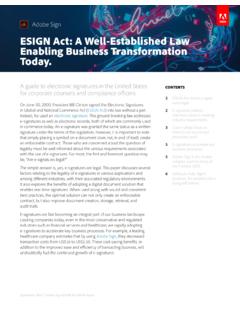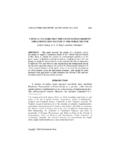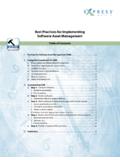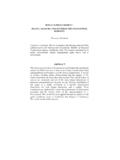Transcription of Electronic signatures in Australia: Legal considerations ...
1 Electronic signatures in australia WhitepaperElectronic signatures in australia : Legal considerations and recommended best practicesAn Adobe/Norton Rose Fulbright Whitepaper1 Executive summaryWorldwide, organisations are adopting Electronic signature solutions to help reduce their carbon footprint, streamline business processes, improve security and record-keeping, and reduce costs. It is projected that over 100 million Electronic signature transactions will be made annually in australia by Yet, a recent study has found that less than 20% of Australian businesses are currently prepared for Australian law allows nearly every document to be signed using Electronic signatures .
2 In these cases, Electronic signatures are legally equivalent to their wet-ink counterparts and businesses would benefit from their adoption. Almost all agreements used in typical business departments, such as sales, human resources, Legal and procurement in their day-to-day operations, are capable of being signed electronically. In this paper, we will review the law as it relates to Electronic signatures by analysing how such signatures are treated under the Commonwealth and State Electronic transactions legislation (ET Legislation) and how such signatures are treated under general Electronic signatures in Electronic transactions legislationAustralian law recognises that a transaction can be executed through Electronic communications.
3 The ET Legislation facilitates Electronic transactions rather than imposing any additional regulatory burden. A Legal requirement for a signature is met under ET Legislation if the following three requirements are satisfied:(1)Identification RequirementThe method used to sign identifies the person who is signing and indicates an intention by them tosign that signature solutions will generally satisfy this requirement.(2)Reliability RequirementThe method used to sign was reliable in light of all the is objectively determined with reference to a number of factors, including the type of documentbeing signed.
4 A wide variety of signature methods have been found to be reliable . For example, asimple exchange of emails has been held to satisfy this signature solutions will generally satisfy this requirement.(3)Consent RequirementThe counterparty to the document being electronically signed has consented to the signing partysigning the document by way of Electronic signature solutions will generally satisfy this F orrester Consulting, Adobe eSignature Market study (2016) .2 Ibid2 Electronic signatures in australia Guidance on the signing requirements of the ET LegislationAustralian cases on Electronic signatures generally indicate that:(1)Courts consider that the relevant Electronic transactions legislation was intended to facilitateelectronic signing.
5 (2)The Identification Requirement does not require the recipient of the Electronic communication tohave separately verified the identity of the signatory, only that the identity of the signatory and theirintention in relation to the information communicated can be determined (including by referring toother evidence);(3)The particular purpose for which the signature is required ( the type of document, the value andimportance of the transaction) needs to be considered in each case, since it could affect whether themethod used for signing satisfied the Reliability Requirement; and(4)The Consent Requirement is unlikely to require anything in addition to the relevant party s act ofsigning Ltd and another v Electoral Commissioner [2010] FCA 869Ms Trevitt applied for enrolment under the Commonwealth Electoral Act 1918.
6 Her application was submitted via an online platform which included provision for Electronic signing by using a stylus or finger on the computer trackpad. When printed, the signature had a similar appearance to a faxed signature ( slightly pixelated). The application was rejected by the Electoral Commissioner citing concerns regarding the signature and that it would not be reliable for use as a specimen signature in future. The court rejected these concerns and held that the signature was valid. Claremont 24-7 Pty Ltd v Invox Pty Ltd [No 2] [2015] WASC 220In March 2015, the court considered the requirements in the context of whether an agreement for lease of land evidenced by email had been signed.
7 The lessor sent an email (with his name) attaching the agreed terms to the proposed lessee, confirming that they were acceptable. The court held that that the lease was in writing and had been signed as required by the Property Law Act 1969 (WA). Electronic signing under general lawThe ET Legislation does not apply universally. There are certain documents which are excluded from the operation of the ET Legislation. Wills, powers of attorney and documents relating to dealings with land are some examples of documents which are excluded from the operation of the ET , exclusion from the ET Legislation does not necessarily preclude a document from being signed electronically.
8 If a document is excluded, the general law supports the efficacy of Electronic signing without the need to rely on any facilitating legislation. The general law requirements in relation to Electronic signing are no more onerous than the requirements of the ET Legislation. This can be seen from the cases discussed below, many of which rely on the general law to determine the validity of Electronic signatures without relying on the ET Legislation. As can be seen, the threshold for an Electronic signature to be valid is generally quite low. Even very simplistic methods of signature , like a counterparty s name appearing at the bottom of an email in normal typeface, have been held to be signatures in australia WhitepaperMcGuren v Simpson [2004] NSWSC 35 Mr Simpson sought the recovery of certain money from Ms McGuren.
9 It was held that a short email from Ms McGuren with her name appearing in the From field in the email was signed for the purposes of section 54 of the Limitation Act 1969 (NSW).Stuart v Hishon [2013] NSWSC 766 The court found that a typed first name at the end of the email in question was enough to constitute a signature for the purposes of section 54 of the Limitation Act 1969 (NSW). The court noted that it would be an almost lethal assault on common sense to take any other view. Kavia Holdings Pty Limited v Suntrack Holdings Pty Limited [2011] NSWSC 716 This case related to a contractual requirement for signing in the context of an option to renew a lease.
10 The court stated that the inclusion of the sender s name on the email amounted to signing for the purposes of the clause. The requirement for signing is intended to identify the sender and authenticate the communication. Smythe v Thomas [007] NSWSC 844 The court considered the disputed purchase of an aircraft on eBay. The eBay terms and conditions stated that once a bid was received above the reserve price, both parties were bound to complete the transaction. The seller refused to accept the deposit, claiming that the purchaser was obliged to inspect the aircraft before a contract could be concluded.











